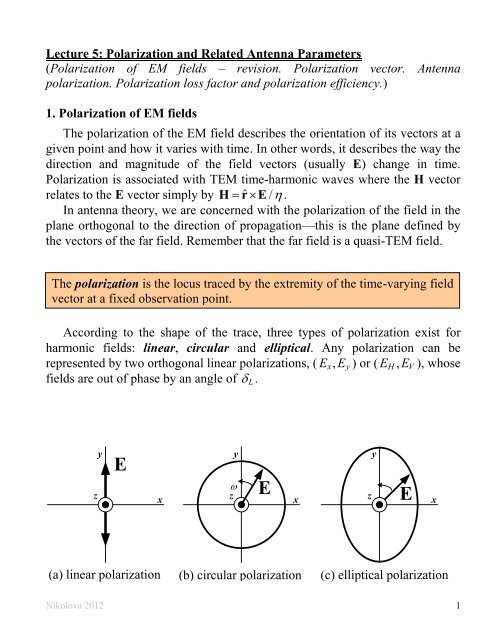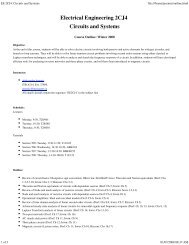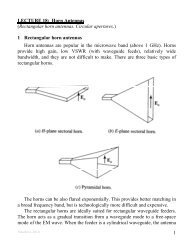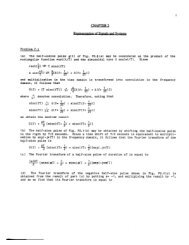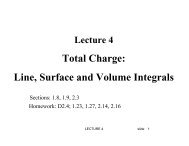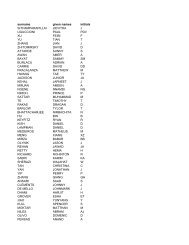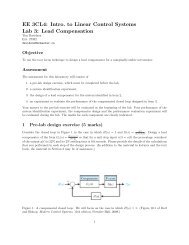Lecture 5: Polarization and Related Antenna Parameters
Lecture 5: Polarization and Related Antenna Parameters
Lecture 5: Polarization and Related Antenna Parameters
Create successful ePaper yourself
Turn your PDF publications into a flip-book with our unique Google optimized e-Paper software.
<strong>Lecture</strong> 5: <strong>Polarization</strong> <strong>and</strong> <strong>Related</strong> <strong>Antenna</strong> <strong>Parameters</strong><br />
(<strong>Polarization</strong> of EM fields – revision. <strong>Polarization</strong> vector. <strong>Antenna</strong><br />
polarization. <strong>Polarization</strong> loss factor <strong>and</strong> polarization efficiency.)<br />
1. <strong>Polarization</strong> of EM fields<br />
The polarization of the EM field describes the orientation of its vectors at a<br />
given point <strong>and</strong> how it varies with time. In other words, it describes the way the<br />
direction <strong>and</strong> magnitude of the field vectors (usually E) change in time.<br />
<strong>Polarization</strong> is associated with TEM time-harmonic waves where the H vector<br />
relates to the E vector simply by H rˆ E<br />
/ .<br />
In antenna theory, we are concerned with the polarization of the field in the<br />
plane orthogonal to the direction of propagation—this is the plane defined by<br />
the vectors of the far field. Remember that the far field is a quasi-TEM field.<br />
The polarization is the locus traced by the extremity of the time-varying field<br />
vector at a fixed observation point.<br />
According to the shape of the trace, three types of polarization exist for<br />
harmonic fields: linear, circular <strong>and</strong> elliptical. Any polarization can be<br />
represented by two orthogonal linear polarizations, ( Ex, E y)<br />
or ( EH, E V),<br />
whose<br />
fields are out of phase by an angle of L .<br />
z<br />
y<br />
E<br />
x<br />
y<br />
z <br />
E<br />
x<br />
z E<br />
(a) linear polarization (b) circular polarization (c) elliptical polarization<br />
Nikolova 2012 1<br />
y<br />
x
If L 0 or n , then linear polarization results.<br />
t <br />
0<br />
t e ( t)<br />
only<br />
H<br />
e ( t)<br />
only<br />
H<br />
t <br />
e () t<br />
e () t<br />
Animation: Linear <strong>Polarization</strong>, L 0,<br />
Ex Ey<br />
Nikolova 2012 2<br />
0<br />
t H<br />
e () t<br />
V<br />
V<br />
e () t<br />
H
If / 2 (90 ) <strong>and</strong> | E | | E | , then circular polarization results.<br />
t1<br />
L<br />
x y<br />
t t <br />
2 1 /2<br />
Animation: Clockwise Circular Rotation<br />
In the most general case, elliptical polarization is defined.<br />
t <br />
0<br />
t /2<br />
Animation: Counter-clockwise Elliptical Rotation<br />
It is also true that any type of polarization can be represented by a righth<strong>and</strong><br />
circular <strong>and</strong> a left-h<strong>and</strong> circular polarizations ( E L,<br />
E R ). Next, we review<br />
the above statements <strong>and</strong> definitions, <strong>and</strong> introduce the new concept of<br />
polarization vector.<br />
Nikolova 2012 3
2. Field polarization in terms of two orthogonal linearly polarized<br />
components<br />
The polarization of any field can be represented by a set of two orthogonal<br />
linearly polarized fields. Assume that locally a far-field wave propagates along<br />
the z-axis. The far-zone field vectors have only transverse components. Then,<br />
the set of two orthogonal linearly polarized fields along the x-axis <strong>and</strong> along<br />
the y-axis, is sufficient to represent any TEMz field. We use this arrangement to<br />
introduce the concept of polarization vector.<br />
The field (time-dependent or phasor vector) is decomposed into two<br />
orthogonal components:<br />
e ex ey E Ex E y,<br />
(5.1)<br />
ex Excos tzxˆ e E cos t z <br />
yˆ<br />
<br />
Ex Exxˆ<br />
E EejLyˆ.<br />
(5.2)<br />
<br />
y y L<br />
y y<br />
At a fixed position (assume z 0),<br />
equation (5.1) can be written as<br />
e( t) xˆEcostyˆEcos( t )<br />
x y L<br />
ˆ E ˆ E e j L <br />
E x y <br />
x y<br />
Case 1: Linear polarization: Ln, n<br />
0,1,2,<br />
e( t) xˆEcos( t) yˆEcos(<br />
t n<br />
)<br />
E y<br />
y<br />
(a)<br />
x y<br />
E xˆE yˆE<br />
2k<br />
L<br />
0 E<br />
<br />
E x<br />
x<br />
x y<br />
Ey arctan <br />
E<br />
<br />
x <br />
(2k1) <br />
(5.3)<br />
(5.4)<br />
Nikolova 2012 4<br />
E<br />
y<br />
L<br />
E<br />
(b)<br />
y<br />
<br />
0<br />
Ex<br />
x
Case 2: Circular polarization:<br />
3<br />
t <br />
5<br />
2<br />
t <br />
4<br />
t 3<br />
t <br />
4<br />
Ex Ey Em <strong>and</strong> L n, n 0,1,2,<br />
2 <br />
e( t) xˆEcos( t) yˆEcos[<br />
t ( / 2 n<br />
)]<br />
x y<br />
E E ( xˆ jyˆ)<br />
E E ( xˆ jyˆ)<br />
m<br />
<br />
L2n 2<br />
y<br />
z<br />
t<br />
2<br />
<br />
<br />
m<br />
7<br />
t <br />
4<br />
t<br />
4<br />
<br />
<br />
t 0<br />
x<br />
If z ˆ is the direction of<br />
propagation: counterclockwise<br />
(CCW) or left-h<strong>and</strong> polarization<br />
t <br />
t 5<br />
t <br />
4<br />
E E ( xˆ jyˆ)<br />
t y<br />
2<br />
<br />
<br />
L2n 2<br />
<br />
3<br />
4<br />
3<br />
t <br />
2<br />
(5.5)<br />
t<br />
4<br />
<br />
<br />
t 0<br />
x<br />
7<br />
t <br />
4<br />
Note that the sense of rotation changes if the direction of propagation changes.<br />
In the example above, if the wave propagates along z, ˆ the plot to the left,<br />
where E Em( xˆ jy<br />
ˆ)<br />
, corresponds to a right-h<strong>and</strong> wave, while the plot to the<br />
right, where E E ( xˆ jy<br />
ˆ)<br />
, corresponds to a left-h<strong>and</strong> wave.<br />
m<br />
If ˆ<br />
z is the direction of<br />
propagation: clockwise (CW) or<br />
right-h<strong>and</strong> polarization<br />
Nikolova 2012 5<br />
m<br />
z
A snapshot of the field vector (at a particular moment of time) along the axis<br />
of propagation is given below for a left-h<strong>and</strong> circularly polarized wave<br />
travelling along z.<br />
Pick an observing position along the z axis <strong>and</strong><br />
imagine that the whole helical trajectory of the tip of the field vector moves<br />
along z.<br />
Are you going to see the vector rotating clockwise or counterclockwise<br />
(as you look toward z ). (Ans.: counter-clockwise)<br />
y<br />
Case 3: Elliptic polarization<br />
x<br />
The field vector at a given point traces an ellipse as a function of time. This<br />
is the most general type of polarization, obtained for any phase difference <br />
<strong>and</strong> any ratio ( Ex / E y)<br />
. Mathematically, the linear <strong>and</strong> the circular<br />
polarizations are special cases of the elliptical polarization. In practice,<br />
however, the term elliptical polarization is used to indicate polarizations other<br />
than linear or circular.<br />
( t) ˆExcostˆEycos( t L)<br />
ˆEˆEejL <br />
e x y <br />
(5.6)<br />
E x y<br />
x y<br />
<br />
z<br />
Nikolova 2012 6
Show that the trace of the time-dependent vector is an ellipse:<br />
e ( t) E (cost cos sin t sin )<br />
y y L L<br />
ex() t<br />
ex() t <br />
cost<br />
<strong>and</strong> sint 1<br />
E<br />
<br />
x<br />
E<br />
<br />
x <br />
2<br />
ex( t) ex( t)<br />
ey t ey t<br />
L L<br />
E <br />
x E <br />
<br />
x Ey Ey<br />
sin2 <br />
<br />
2<br />
<br />
<br />
<br />
<br />
( ) <br />
cos <br />
<br />
<br />
<br />
( ) <br />
<br />
<br />
or (dividing both sides by sin2 L ),<br />
1 x2( t) 2 x( t) y( t)cos 2<br />
L y ( t)<br />
,<br />
where<br />
ex( t) cost<br />
xt () ,<br />
Ex<br />
sinLsinL ey() t cos( tL) yt () .<br />
E sin sin<br />
(5.7)<br />
y L L<br />
Equation (5.7) is the equation of an ellipse centered in the xy plane. It<br />
describes the trajectory of a point of coordinates x(t) <strong>and</strong> y(t), i.e., normalized<br />
ex() t <strong>and</strong> ey() t values, along an ellipse where the point moves with an angular<br />
frequency .<br />
As the circular polarization, the elliptical polarization can be right-h<strong>and</strong>ed<br />
or left-h<strong>and</strong>ed, depending on the relation between the direction of propagation<br />
<strong>and</strong> the direction of rotation.<br />
e () t<br />
y<br />
major axis (2 OA)<br />
E<br />
<br />
Ey<br />
minor axis (2 OB)<br />
Nikolova 2012 7<br />
<br />
2<br />
Ex<br />
ex() t<br />
2
The parameters of the polarization ellipse are given below. Their derivation<br />
is given in Appendix I.<br />
a) major axis (2 OA)<br />
OA =<br />
1<br />
E22 x Ey <br />
2 <br />
E4 4 2 2 2<br />
x Ey Ex Ey cos(2 L<br />
) <br />
(5.8)<br />
b) minor axis (2 OB)<br />
OB =<br />
1<br />
E22 x Ey <br />
2 <br />
E4 4 2 2 2<br />
x Ey Ex Ey cos(2 L<br />
) <br />
(5.9)<br />
c) tilt angle <br />
1 2EE<br />
x y <br />
arctan cos<br />
2<br />
2 2<br />
L <br />
Ex Ey<br />
<br />
(5.10)<br />
Note: Eq. (5.10) produces an infinite number of angles, τ = (arctanA)/2<br />
n /2,<br />
n = 1,2,….Thus, it gives not only the angle which the major<br />
axis of the ellipse forms with the x axis but also the angle of the minor<br />
axis with the x axis. In spherical coordinates, τ is usually specified<br />
with respect to the ˆ θ direction<br />
d) axial ratio<br />
Nikolova 2012 8<br />
A<br />
major axis OA<br />
AR (5.11)<br />
minor axis OB<br />
Note: The linear <strong>and</strong> circular polarizations as special cases of the elliptical<br />
polarization:<br />
If L 2n<br />
2 <strong>and</strong> Ex Ey,<br />
then OA OB Ex Ey;<br />
the ellipse<br />
becomes a circle.<br />
If L n,<br />
then OB 0 <strong>and</strong> arctan( Ey / Ex)<br />
; the ellipse collapses<br />
into a line.
3. Field polarization in terms of two circularly polarized components<br />
The representation of a complex vector field in terms of circularly polarized<br />
components is somewhat less easy to perceive but it is actually more useful in<br />
the calculation of the polarization ellipse parameters. This time, the total field<br />
phasor is represented as the superposition of two circularly polarized waves,<br />
one right-h<strong>and</strong>ed <strong>and</strong> the other left-h<strong>and</strong>ed. For the case of a wave propagating<br />
along z [see Case 2 <strong>and</strong> Eq. (5.5)],<br />
E E ( xˆ jyˆ ) E ( xˆ jy<br />
ˆ)<br />
. (5.12)<br />
R L<br />
Here, ER <strong>and</strong> EL are in general complex phasors. Assuming a relative phase<br />
difference of C L R,<br />
one can write (5.12) as<br />
e ( ˆ ˆ) j C<br />
R j eLe( ˆ jˆ<br />
)<br />
E x y x y , (5.13)<br />
where e R <strong>and</strong> e L are real numbers.<br />
The relations between the linear-component <strong>and</strong> the circular-component<br />
representations of the field polarization are easily found as<br />
E xˆ( E E ) y ˆ j( E E )<br />
(5.14)<br />
R L R L<br />
E E<br />
x y<br />
Ex ER EL<br />
<br />
E j( E E)<br />
y R L<br />
ER 0.5( Ex jEy<br />
)<br />
<br />
E 0.5( E jE )<br />
L x y<br />
4. <strong>Polarization</strong> vector <strong>and</strong> polarization ratio<br />
The polarization vector is the normalized phasor of the electric field vector.<br />
It is a complex-valued vector of unit magnitude, i.e., ρˆ ρ ˆ 1.<br />
L L <br />
x y j L<br />
2 2<br />
L e Em Ex Ey<br />
Em Em Em<br />
(5.15)<br />
(5.16)<br />
E E E<br />
ρˆ xˆ y ˆ ,<br />
(5.17)<br />
The polarization vector takes the following specific forms:<br />
Case 1: Linear polarization<br />
Nikolova 2012 9
Ex<br />
Ey<br />
ρˆ xˆ y ˆ ,<br />
Em Em<br />
Em E2 2<br />
x Ey<br />
(5.18)<br />
where E x <strong>and</strong> E y are real numbers.<br />
Case 2: Circular polarization<br />
ρˆ L <br />
1<br />
xˆ jy ˆ ,<br />
2<br />
Em 2Ex 2Ey<br />
(5.19)<br />
The polarization ratio is the ratio of the phasors of the two orthogonal<br />
polarization components. In general, it is a complex number:<br />
E j L<br />
y Eye EV<br />
r L<br />
L rLe or rL<br />
(5.20)<br />
E E E<br />
x x H<br />
Point of interest: In the case of circular-component representation, the<br />
polarization ratio is defined as<br />
r r e<br />
j<br />
C <br />
C . (5.21)<br />
EL<br />
C R<br />
The circular polarization ratio r C is of particular interest since the axial ratio of<br />
the polarization ellipse AR can be expressed as<br />
rC<br />
1<br />
AR . (5.22)<br />
r 1<br />
Besides, its tilt angle with respect to the y (vertical) axis is simply<br />
/2<br />
Nikolova 2012 10<br />
C<br />
E<br />
V C . (5.23)<br />
Comparing (5.10) <strong>and</strong> (5.23) readily shows the relation between the phase<br />
difference δC of the circular-component representation <strong>and</strong> the linear<br />
polarization ratio r j L<br />
L rLe :<br />
2rL<br />
<br />
C arctan cos<br />
1 2<br />
L<br />
r<br />
.<br />
(5.24)<br />
L <br />
We can calculate r C from the linear polarization ratio r L making use of (5.11)<br />
<strong>and</strong> (5.22):
C 1<br />
1 r2 L 1 r4 2 2<br />
L rL<br />
cos(2 L<br />
)<br />
C 1 1 2<br />
L 1 4 2 2<br />
L L cos(2 L<br />
)<br />
r<br />
AR <br />
. (5.25)<br />
r r r r<br />
Using (5.24) <strong>and</strong> (5.25) allows switching between the representation of the<br />
wave polarization in terms of linear <strong>and</strong> circular components.<br />
5. <strong>Antenna</strong> polarization<br />
The polarization of a transmitting antenna is the polarization of its<br />
radiated wave in the far zone. The polarization of a receiving antenna is the<br />
polarization of a plane wave, incident from a given direction, which, for a<br />
given power flux density, results in maximum available power at the antenna<br />
terminals.<br />
The antenna polarization is defined by the polarization vector of the<br />
radiated (transmitted) wave. Notice that the polarization vector of a wave in the<br />
coordinate system of the transmitting antenna is represented by its complex<br />
conjugate in the coordinate system of the receiving antenna:<br />
ˆr ( ˆt<br />
w w) ρ ρ . (5.26)<br />
The conjugation is without importance for a linearly polarized wave since its<br />
polarization vector is real. It is, however, important in the cases of circularly<br />
<strong>and</strong> elliptically polarized waves.<br />
This is illustrated in the figure below with a right-h<strong>and</strong> CP wave. Let the<br />
t t t<br />
coordinate triplet ( x1, x2, x 3)<br />
represents the coordinate system of the<br />
r r r<br />
transmitting antenna while ( x1, x2, x 3 ) represents that of the receiving antenna.<br />
Note that in antenna theory the plane of polarization is usually given in<br />
spherical coordinates by ( xˆ ˆ<br />
1, xˆ2) ( θφ , ˆ ) <strong>and</strong> the third axis obeys xˆ 1 xˆ2x ˆ 3,<br />
i.e., xˆ3r. ˆ Since the transmitting <strong>and</strong> receiving antennas face each other, their<br />
t r<br />
coordinate systems are oriented so that xˆ3 x<br />
ˆ3<br />
(i.e., ˆr ˆt<br />
r r<br />
). If we align the<br />
axes ˆ1 t x <strong>and</strong> ˆ1 r x , then ˆt 2 ˆr<br />
x x<br />
2 must hold. This changes the sign in the<br />
imaginary part of the wave polarization vector.<br />
Nikolova 2012 11
RHCP wave<br />
t<br />
x2<br />
t<br />
x1<br />
ˆ ˆ t<br />
k x<br />
t /2<br />
x<br />
t 1 t t<br />
ρˆ w ( xˆ1 jxˆ2)<br />
2<br />
3<br />
t<br />
3<br />
Nikolova 2012 12<br />
r<br />
x3<br />
r<br />
x1<br />
t 0<br />
t 0<br />
r<br />
x2<br />
ˆ ˆ 3<br />
r<br />
k x<br />
t /2<br />
r 1 r r<br />
ρˆ w ( xˆ1 jxˆ2)<br />
2<br />
Bearing in mind the definitions of antenna polarization in transmitting <strong>and</strong><br />
receiving modes, we conclude that the transmitting-mode polarization vector<br />
of an antenna is the conjugate of its receiving-mode polarization vector.<br />
6. <strong>Polarization</strong> loss factor <strong>and</strong> polarization efficiency<br />
Generally, the polarization of the receiving antenna is not the same as the<br />
polarization of the incident wave. This is called polarization mismatch.<br />
The polarization loss factor (PLF) characterizes the loss of EM power<br />
because of polarization mismatch:<br />
PLF | ρˆ ˆ | 2<br />
iρ a . (5.27)<br />
The above definition is based on the representation of the incident field <strong>and</strong> the<br />
antenna polarization by their polarization vectors. If the incident field is<br />
Ei Ei<br />
mρ ˆ i,<br />
then the field of the same magnitude that would produce maximum received<br />
power at the antenna terminals is<br />
E Ei<br />
ρ ˆ .<br />
a m a
If the antenna is polarization matched, then PLF 1,<br />
<strong>and</strong> there is no<br />
polarization power loss. If PLF 0,<br />
then the antenna is incapable of receiving<br />
the signal.<br />
0 PLF 1<br />
(5.28)<br />
The polarization efficiency means the same as the PLF.<br />
Examples<br />
Example 5.1. The electric field of a linearly polarized EM wave is<br />
i ˆ E ( , ) j z<br />
m x y e <br />
E x <br />
.<br />
It is incident upon a linearly polarized antenna whose polarization is<br />
Ea ( xˆ y ˆ)<br />
Er ( , , ) .<br />
Find the PLF.<br />
Nikolova 2012 13
PLF xˆ <br />
1<br />
( xˆ y ˆ)<br />
2<br />
1<br />
<br />
2<br />
PLF 10log 0.5 3 dB<br />
[dB] 10<br />
2<br />
Example 5.2. A transmitting antenna produces a far-zone field, which is<br />
RH circularly polarized. This field impinges upon a receiving antenna,<br />
whose polarization (in transmitting mode) is also RH circular. Determine<br />
the PLF.<br />
Both antennas (the transmitting one <strong>and</strong> the receiving one) are RH<br />
circularly polarized in transmitting mode. Assume that a transmitting<br />
antenna is located at the center of a spherical coordinate system. The farzone<br />
field it would produce is described as<br />
E far E ˆ<br />
m cost ˆ cos( t <br />
/ 2) <br />
<br />
θ φ<br />
<br />
It is a RH circularly polarized field with respect to the outward radial<br />
direction. Its polarization vector is<br />
θˆjφˆ ρ ˆ .<br />
2<br />
This is exactly the polarization vector of the transmitting antenna.<br />
x<br />
<br />
z<br />
E <br />
r<br />
Nikolova 2012 14<br />
E<br />
y
This same field Ε far is incident upon a receiving antenna, which has the<br />
polarization vector ρˆ ( ˆ<br />
a θa jφ<br />
ˆa)<br />
/ 2 in its own coordinate system<br />
( ra , a, a)<br />
. However, Ε far propagates along r ˆa in the ( ra , a, a)<br />
coordinate system, <strong>and</strong>, therefore, its polarization vector becomes<br />
θˆ a jφˆa<br />
ρ ˆ i .<br />
2<br />
The PLF is calculated as<br />
ˆ ˆ ˆ ˆ 2<br />
2 | ( θa jφa)( θa jφa)<br />
|<br />
PLF | ρˆiρ ˆa<br />
| 1,<br />
PLF[dB] 10log101 0.<br />
4<br />
There are no polarization losses.<br />
Exercise: Show that an antenna of RH circular polarization (in transmitting<br />
mode) cannot receive LH circularly polarized incident wave (or a wave<br />
emitted by a left-circularly polarized antenna).<br />
Appendix I<br />
Find the tilt angle , the length of the major axis OA, <strong>and</strong> the length of the<br />
minor axis OB of the ellipse described by the equation:<br />
2<br />
x x<br />
( ) ( )<br />
2 e ( t) e ( t)<br />
ey t ey t <br />
sin 2 cos<br />
E <br />
x E <br />
x Ey Ey<br />
<br />
ey() t<br />
major axis (2 OA)<br />
E<br />
<br />
Ey<br />
minor axis (2 OB)<br />
ex() t<br />
Nikolova 2012 15<br />
<br />
Ex<br />
2<br />
.<br />
(A-1)
Equation (A-1) can be written as<br />
a x2bxycy2 1,<br />
(A-2)<br />
where<br />
x ex() t <strong>and</strong> y ey() t are the coordinates of a point of the ellipse<br />
centered in the xy plane;<br />
1<br />
a ;<br />
E2sin2 x <br />
2cos<br />
b ;<br />
EE sin2<br />
x y <br />
1<br />
c .<br />
E2sin2 y <br />
After dividing both sides of (A-2) by ( xy ) , one obtains<br />
x y 1<br />
a b c .<br />
(A-3)<br />
y x xy<br />
y ey() t<br />
Introducing , one obtains that<br />
x ex() t<br />
2 1<br />
x <br />
c2b a<br />
1<br />
<br />
( ) (1 ) .<br />
2<br />
2 x2 y2 x2<br />
2 <br />
c2b a<br />
Here, is the distance from the center of the coordinate system to the point on<br />
the ellipse. We want to know at what values of the maximum <strong>and</strong> the<br />
minimum of occur ( min , max ). This will produce the tilt angle . We also<br />
want to know the values of max (major axis) <strong>and</strong> min (minor axis). Then, we<br />
have to solve<br />
d(<br />
2)<br />
0,<br />
or<br />
d<br />
2 2( ac) m m<br />
1 0,<br />
where m min, max<br />
. (A-5)<br />
b<br />
(A-5) is solved for the angle τ, which relates to ξmax as<br />
tan y/ x<br />
.<br />
(A-6)<br />
max max<br />
(A-4)<br />
Nikolova 2012 16
Substituting (A-6) in (A-5) yields:<br />
sin sin<br />
<br />
2C 1 0<br />
cos cos<br />
<br />
where<br />
2 2<br />
ac Ey Ex<br />
C .<br />
b 2ExEycos Multiplying both sides of (A-7) by cos2 <strong>and</strong> re-arranging results in<br />
2 2 cos sin 2C sin cos 0.<br />
Thus, the solution of (A-7) is<br />
or<br />
2<br />
cos(2 ) Csin(2<br />
)<br />
tan(2 ) 1/ C<br />
1 2EE cos<br />
<br />
arctan ;<br />
x y<br />
1 2 2 2 1 .<br />
2 Ex Ey<br />
2<br />
The angles τ1 <strong>and</strong> τ2 are the angles between the major <strong>and</strong> minor axes with the x<br />
axis. Substituting 1 <strong>and</strong> 2 back in (see A-4) yields the expressions for OA<br />
<strong>and</strong> OB.<br />
(A-7)<br />
(A-8)<br />
Nikolova 2012 17


